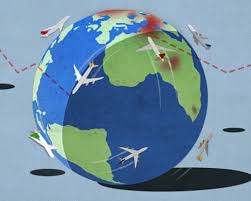The intensifying conflict in the Middle East has added yet another layer of complication to global aviation, with airlines scrambling to find safe, viable routes amid mounting no-fly zones. While former President Trump’s ceasefire announcement offered a glimmer of hope, industry analysts warned that any disruption to air traffic in the Gulf – one of the world’s busiest flight corridors – has a cascading effect worldwide.
British Airways, Singapore Airlines, Air France-KLM and Finnair were among carriers that grounded flights to cities like Doha and Dubai over the weekend. Finnair suspended operations to Doha until month-end. While some flights resumed briefly, Qatar closed its airspace again Monday night after Iran launched another missile salvo.
Airspace over Iraq, Iran, Israel, Syria, Lebanon and parts of Egypt remains restricted or entirely closed. The European Union Aviation Safety Agency (EASA) continues to advise against flying over large swathes of the region. The global air route grid is now being redrawn in real-time, with many airlines forced to detour north through Georgia and Afghanistan or south via Saudi Arabia.
The situation has placed enormous strain on carriers already struggling to maintain schedules in the face of high jet fuel prices and ongoing labor shortages. John Strickland, an aviation analyst, noted that longer routes are not only expensive due to fuel costs but are pushing crew duty hours beyond regulatory limits, causing further cancellations.
The geopolitical crunch has exposed vulnerabilities created by earlier disruptions, including the closure of Ukrainian airspace and bans on Western airlines using Russian routes, both of which have already rerouted a significant portion of global flights. As these new no-go zones emerge, the pressure on global aviation corridors is reaching a boiling point.



